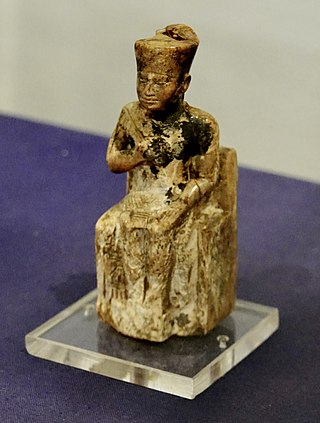
Khufu or Cheops was an ancient Egyptian monarch who was the second pharaoh of the Fourth Dynasty, in the first half of the Old Kingdom period. Khufu succeeded his father Sneferu as king. He is generally accepted as having commissioned the Great Pyramid of Giza, one of the Seven Wonders of the Ancient World, but many other aspects of his reign are poorly documented.

The Bent Pyramid is an ancient Egyptian pyramid located at the royal necropolis of Dahshur, approximately 40 kilometres (25 mi) south of Cairo, built under the Old Kingdom Pharaoh Sneferu. A unique example of early pyramid development in Egypt, this was the second pyramid built by Sneferu.

The Egyptian pyramids are ancient masonry structures located in Egypt. Sources cite at least 118 identified "Egyptian" pyramids. Approximately 80 pyramids were built within the Kingdom of Kush, now located in the modern country of Sudan. Of those located in modern Egypt, most were built as tombs for the country's pharaohs and their consorts during the Old and Middle Kingdom periods.

The Fourth Dynasty of ancient Egypt is characterized as a "golden age" of the Old Kingdom of Egypt. Dynasty IV lasted from c. 2613 to 2494 BC. It was a time of peace and prosperity as well as one during which trade with other countries is documented.

Huni was an ancient Egyptian king, the last pharaoh of the Third Dynasty of Egypt during the Old Kingdom period. Following the Turin king list, he is commonly credited with a reign of 24 years, ending c. 2613 BC.
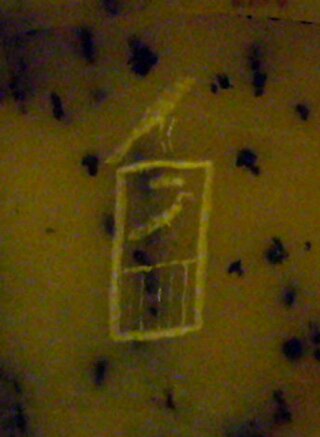
Khaba was a pharaoh of Ancient Egypt, active during the 3rd Dynasty of the Old Kingdom period. The exact time during which Khaba ruled is unknown but may have been around 2670 BC, and almost definitely towards the end of the dynasty.

Meidum, Maydum or Maidum is an archaeological site in Lower Egypt. It contains a large pyramid and several mudbrick mastabas. The pyramid was Egypt's first straight-sided one, but it partially collapsed in ancient times. The area is located around 72 kilometres (45 mi) south of modern Cairo.

Khnumhotep and Niankhkhnum were ancient Egyptian royal servants. They shared the title of Overseer of the Manicurists in the Palace of King Nyuserre Ini, sixth pharaoh of the Fifth Dynasty, reigning during the second half of the 25th century BC. They were buried together at Saqqara and are listed as "royal confidants" in their joint tomb. They are notable for their unusual depiction in Egyptian records, often interpreted as the first recorded same-sex couple.
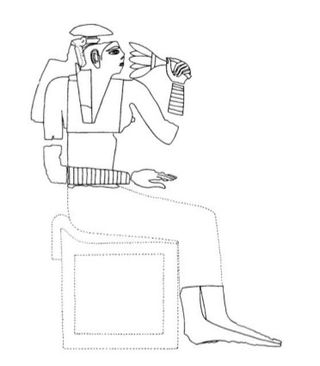
Hetepheres I was a queen of Egypt during the Fourth Dynasty of Egypt who was a wife of one king, the mother of the next king, the grandmother of two more kings, and the figure who tied together two dynasties.

The Mastabat al-Fir'aun is the grave monument of the ancient Egyptian king Shepseskaf, the last king of the Fourth Dynasty documented to date. It is located in South Saqqara halfway between the Pyramid of Djoser at Saqqara and the pyramids of Sneferu, the founder of the Fourth Dynasty, at Dahshur. The structure is located close to the pyramid of Pepi II, a ruler of the Sixth Dynasty. The stone quarry for the structure is located west of the Red Pyramid of Sneferu.
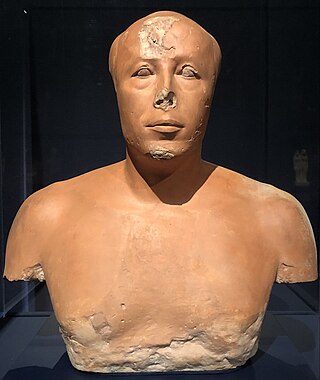
Ankhhaf was an Egyptian prince and served as an overseer during the reign of the Pharaoh Khufu, who is thought to have been Ankhhaf's half-brother. One of Ankhaf's titles is also as a vizier, but it is unknown which pharaoh he would have held this title under. He lived during Egypt's 4th Dynasty.
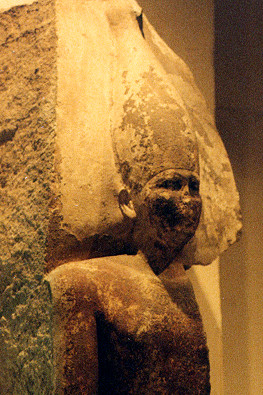
Sneferu, well known under his Hellenized name Soris, was the founding pharaoh of the Fourth Dynasty of Egypt during the Old Kingdom. Estimates of his reign vary, with for instance The Oxford History of Ancient Egypt suggesting a reign from around 2613 to 2589 BC, a reign of 24 years, while Rolf Krauss suggests a 30-year reign, and Rainer Stadelmann a 48-year reign. He built at least three pyramids that survive to this day and introduced major innovations in the design and construction of pyramids.

Prince Rahotep was a prince in ancient Egypt during the 4th Dynasty. He was probably a son of Pharaoh Sneferu and his first wife, although Zahi Hawass suggests his father was Huni.
Ranefer was a prince of ancient Egypt during the 4th Dynasty.
Kanefer is the name of an ancient Egyptian prince. He lived during the 4th or early 5th Dynasty of the Old Kingdom period.

The Tomb of Akhethetep, also known as Mastaba of Akhethetep, is a tomb complex in Saqqarah, Egypt. It was built for Akhethetep, a royal official, near the western part of the Pyramid of Djoser. Akhethetep was an official with several, mainly religious titles. including priest of Heka, priest of Khnum and priest of Horus. The tomb's decorated chapel was removed in 1903 and reassembled at the Louvre in Paris, where it is also known as the "Mastaba of Akhethetep" or simply "le mastaba du Louvre".
Pehernefer is the personal name of an ancient Egyptian high official, who held office under the reigns of the pharaohs Huni and Sneferu, in the time between the end of 3rd Dynasty and the beginning of the 4th Dynasty during the Old Kingdom period.

Metjen was an ancient Egyptian high official at the transition time from 3rd Dynasty to 4th Dynasty. He is famous for his tomb inscription, which provide that he worked and lived under the kings (pharaohs) Huni and Sneferu.
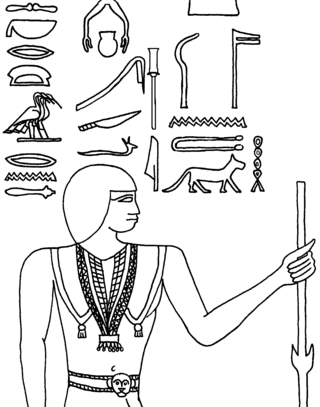
Khabawsokar was an Ancient Egyptian high official during the early to midst 3rd dynasty. He is famous for his tomb inscription and his unique nickname.
Akhetaa was an ancient Egyptian high official during the mid to late 3rd Dynasty. He is mostly known for his tomb inscriptions, which refer to various seldom used titles as well as to the shadowy king Nebka, in whose cult Akhetaa served.















